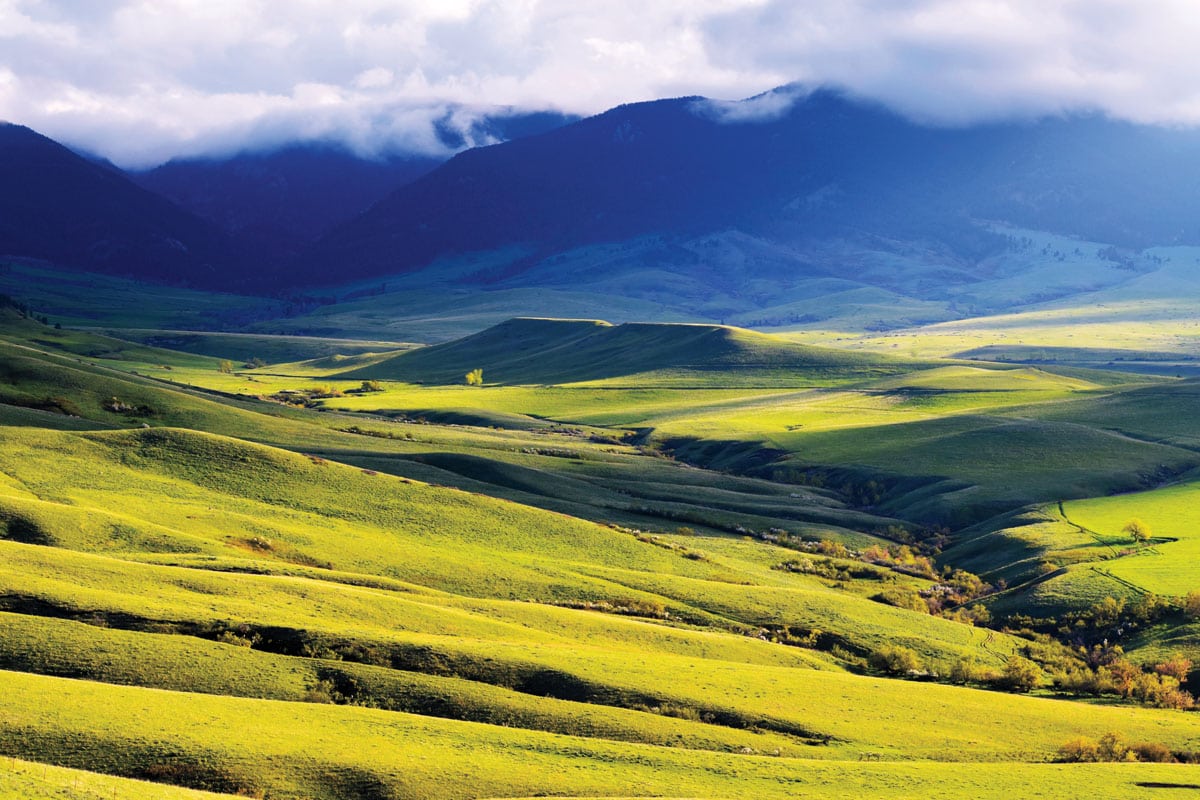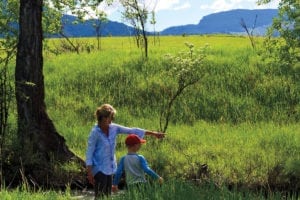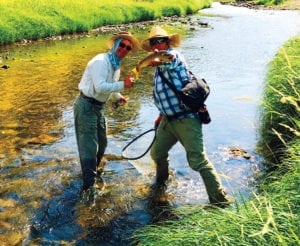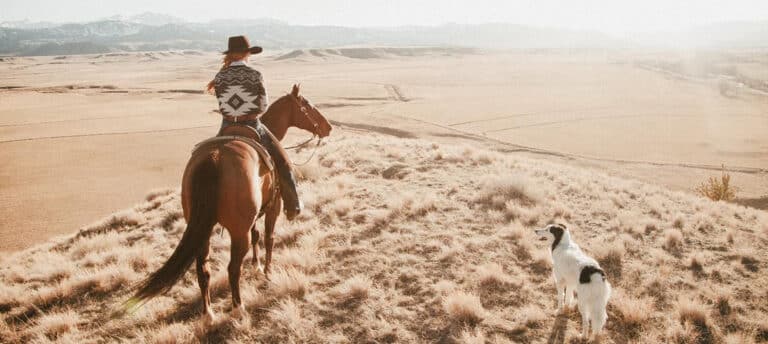The Bighorn Mountain Foothills may just be the best-kept secret in the American West. Rich in wildlife and scenery, the abundance has attracted people from the time the Plains Indians lived here. It has played host to many famous vistors, including Queen Elizabeth II (1984) and Charles Lindburgh. Its beauty has influenced all who visit and convinced many to stay. Crazy Horse, of the Oglala Lakota Sioux, spent a large part of his life in this highly sought after and lush environment that so many early western settlers chose to call home. When the Plains Indians inhabited the region, so too did all their horses. Not only is the land along the Bighorn Mountains a special place for people to live, work and play; it’s also some of the finest horse country in the world. Together, people and horses have established a longstanding relationship that molded into a world-class destination and became a way of life.

It’s a place where people from all walks of life blend and enjoy the riches of a brand of cosmopolitan-cowboy culture, crafted from over 138 years of cowboys, polo, rodeo, ranching, dude ranches, hunting and fishing, outdoor recreation, arts and philanthropy. Born from an equestrian way of life, in a community that sprang up along the Bozeman Trail, the Sheridan Lifestyle is like no other. It has retained the sophistication of the early remittance men who first settled here while maintaining the priceless simplicity and friendliness of neighbors helping neighbors in a rural setting. It’s a lifestyle that reduces stress and increases quality of life.
Sam Morton, a local author whose colorful and highly acclaimed book, Where the Rivers Run North, describes in entertaining detail the early days of the area, which helped solidify this community’s strong foundation and long-standing respect for cultural heritage.
Big Horn’s location was once the prime hunting ground for five rival Indians tribes. After that, John Bozeman staked out an Immigrant Trail, which started Red Cloud’s War. The pristine area at the mouth of Little Goose Canyon, with babbling brooks and rolling meadows became a choice hideout for a variety of outlaws from the James Gang, Butch Cassidy and other men who didn’t mind living next to mountain lions and grizzly bears. Once the law showed up, pioneer settlers like “Bear” Davis, who laid out over sixty bears, braved the elements and formed a community called Big Horn.
It wasn’t long before foreign sportsmen enamored with the image of the Wild West, were drawn to the area. Big Horn had elk, antelope, deer, bear, mountain lion and a wide variety of game birds. It wasn’t ten years after George Custer lost his scalp to Sioux and Cheyenne warriors, that British thoroughbred horse breeders had thousands of imported horses turned out on the grasslands. The reason the Indians raised great war horses was the same reason thoroughbreds from Big Horn started showing up in England. The rich grasslands built strong horses.”

Morton continues; “Retired Army officers from England including the Stockwell brothers and Captain Grissell, who brought the first polo game to England from India all moved to the area. The first polo game was played in Sheridan six miles away from Big Horn in 1893 between the British and some cowboys and within five years, in 1898 Big Horn had its first game on a flat at the foot of the canyon. The flat was part of an old battlefield between Crow and Cheyenne tribes in the mid eighteen hundreds. These flats became home to practice games between foreign ranchers and local cowboys.
The primary mover in all this was Malcolm Moncreiffe from Scotland who kept improving the polo field and organizing games. In 1899 the Big Horn polo field was temporarily transformed into a large-scale horse inspection station as over thirty thousand horses were inspected to ship off to South Africa. The original Big Horn polo team of Malcolm Moncreiffe, Bob Walsh, Lee Bullington and John Cover were all part of a company that formed a horse-buying spree across the American West intended to resell their horses to the British Army for the Boar War in South Africa. In a three-year period approximately 25,000 horses passed inspection on Moncreiffe’s polo field. The horses that flunked inspection because they bucked their riders over the corral poles ended up as rodeo stars. The riders who survived took their skills as bucking horse riders. Some ended up in Europe in Wild West Shows while others ended up in Madison Square Garden.
 Later in 1915, government buyers from Italy, England, France, and the United States showed up to buy horses off the polo field. By now there was a wide variety of polo enthusiasts settled in Big Horn. The Moncreiffe’s from Scotland, the Wallops from England, the Gallatins from New York, the Forbes from Boston and enough Ivy League polo players to form a sportsman’s club bought ranches here. To promote the horses to foreign buyers, a horse show was staged at the polo field on Moncreiffes ranch, now called the Polo ranch. Sitting at the mouth of Little Goose Canyon, the ranch was a showcase polo estate sitting on lush grasslands at the foot of the snowcapped Bighorn Mountains. A wide cross section of Polo’s “A” list traveled to Moncreiffe’s field. Foxhall Keene came for a visit. Young Tommy Hitchcock played there on a summer vacation with his parents in 1915. Dev Milburn came as a guest of the Gallatins who had the largest polo breeding operation in the US. Charles Lindbergh once landed a plane on the field to see the festivities. In the 1920’s, tribal Chiefs from the Lakota, Cheyenne and Crow tribes, former enemies, camped on the polo fields as guests of the Moncreiffs and Gallatins. This was part of a horse festival featuring polo, steeplechases, flat racing, jumping, and rodeo.”
Later in 1915, government buyers from Italy, England, France, and the United States showed up to buy horses off the polo field. By now there was a wide variety of polo enthusiasts settled in Big Horn. The Moncreiffe’s from Scotland, the Wallops from England, the Gallatins from New York, the Forbes from Boston and enough Ivy League polo players to form a sportsman’s club bought ranches here. To promote the horses to foreign buyers, a horse show was staged at the polo field on Moncreiffes ranch, now called the Polo ranch. Sitting at the mouth of Little Goose Canyon, the ranch was a showcase polo estate sitting on lush grasslands at the foot of the snowcapped Bighorn Mountains. A wide cross section of Polo’s “A” list traveled to Moncreiffe’s field. Foxhall Keene came for a visit. Young Tommy Hitchcock played there on a summer vacation with his parents in 1915. Dev Milburn came as a guest of the Gallatins who had the largest polo breeding operation in the US. Charles Lindbergh once landed a plane on the field to see the festivities. In the 1920’s, tribal Chiefs from the Lakota, Cheyenne and Crow tribes, former enemies, camped on the polo fields as guests of the Moncreiffs and Gallatins. This was part of a horse festival featuring polo, steeplechases, flat racing, jumping, and rodeo.”

The Wild West Shows were those of Buffalo Bill Cody and auditions were staged from the front porch of the Historic Sheridan Inn. He goes on to say that “Sheridan and the foothills of the Bighorn Mountains is a place where every visitor is welcomed. It also has a long-standing tradition of hosting guests at the surrounding dude ranches, Eatons’ Ranch, one of many dude ranches, is the oldest of its kind in the country and continues its 138-year tradition of bringing people together to enjoy the western life and build memories in these beautiful surroundings. This type of hospitality is at the core of cowboy culture and the Sheridan Lifestyle.” My own parents and grandparents were part of the westward migration due to the influence of the dude ranches. And, as Sam Morton says, “you can’t throw a rock down Main Street without hitting someone who came here because of the dude ranches”.
So what is every-day Sheridan like? It’s “a blend of friendly, western ambiance layered with surprising sophistication. It’s a place where handshakes still seal deals and people you’ve never met before will wave to you. This is a great place to live, work and play. Come and experience it for yourself.”
Learn more at BighornMountainFoothills.com
 John was born and raised on a large, family-owned working cattle ranch in the Powder River Basin near Sheridan, Wyoming. He is married with two children, living near Sheridan in the Bighorn Mountain Foothills and has been selling ranch real estate since 2004. He and his brother, Galen, own Chase Brothers Properties—a ranch real estate company in Sheridan, Wyoming • 844-WYO-LAND
John was born and raised on a large, family-owned working cattle ranch in the Powder River Basin near Sheridan, Wyoming. He is married with two children, living near Sheridan in the Bighorn Mountain Foothills and has been selling ranch real estate since 2004. He and his brother, Galen, own Chase Brothers Properties—a ranch real estate company in Sheridan, Wyoming • 844-WYO-LAND


